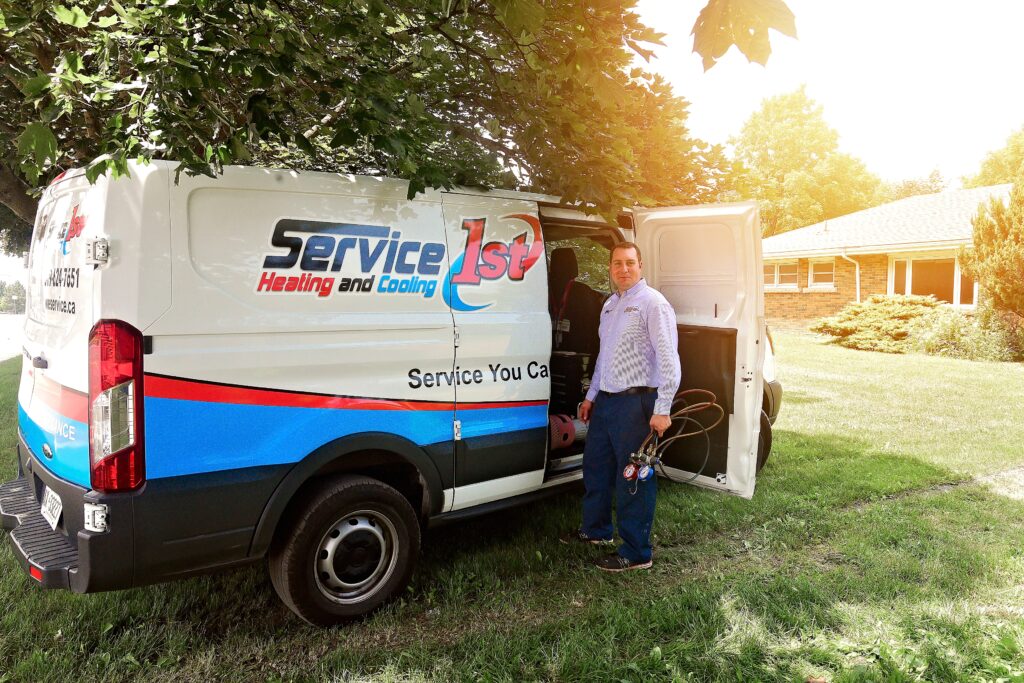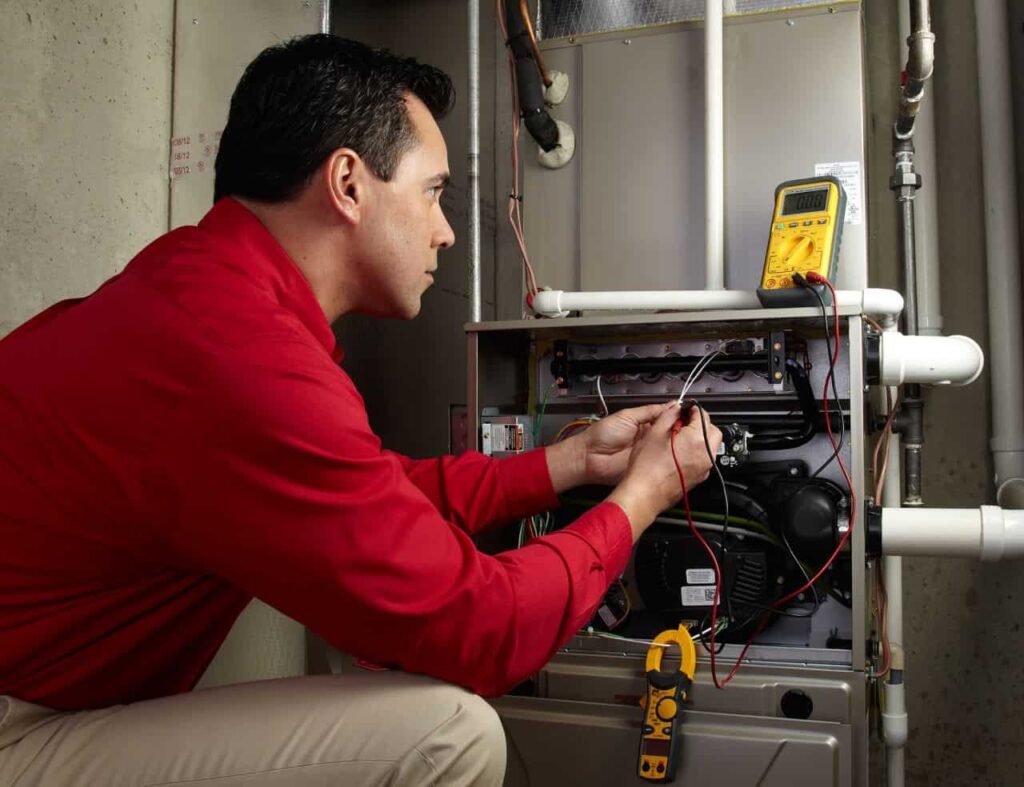
Is your carbon monoxide detector beeping and you aren’t sure what to do, this guide can help. If you hear 4 beeps and then a pause, this is an EMERGENCY. It indicates carbon monoxide has been detected and you should immediately evacuate your home or building and call 9-1-1.
To learn about the different noises your detector makes, what happens if it detects carbon monoxide, and to find out more about carbon monoxide (also called ‘CO’) leaks, continue reading below to click on one of the following links:
Alert #1: Four (4) Loud Beeps and a Pause: Emergency
Alert #2: One (1) Beep/Chirp every minute: Low Battery
Alert #3: Multiple Beeps/Chirp every 30 seconds – 1 minute: End of Life
FAQ: What Is Carbon Monoxide?
FAQ: What Are The Symptoms of Carbon Monoxide Poisoning?
FAQ: How Does Carbon Monoxide Get Into The Home?
FAQ: Who Needs a Carbon Monoxide Detector?
An up-to-date and well maintained furnace is one of the best ways to prevent CO from leaking into your home. Give us a call at Service 1st if you would like to know more about our maintenance plans or if your furnace needs servicing.
Note: This article provides general information and guidelines only. It is not medical advice. Always refer to your carbon monoxide detector’s instructions and label for specific information about your device.
Carbon Monoxide Detector Beeping In Your Home? Here's What To Do

Alert #1: Four (4) Beeps and a Pause: EMERGENCY
If your carbon monoxide detector begins beeping 4 times in a row, takes a pause, and begins beeping again, this indicates a carbon monoxide (CO) leak has been detected.
Have all of your family members evacuate your home or building immediately. After moving to fresh air, call 9-1-1 if anyone is experiencing even mild symptoms of CO poisoning. If no one has any symptoms, you can call the fire department or a qualified HVAC technician. Learn more about what to do if your detector goes off from Kidde Canada.
Many carbon monoxide detectors will come with a display screen to show you levels of detected CO. Sometimes, levels are very low before they set off the alarm, but seeing any number above 0 means you should seek help by calling the fire department or 9-1-1 if anyone is experiencing symptoms of carbon monoxide poisoning.
NEVER ignore an alarm!
Note: Is your carbon monoxide detector beeping? Always refer to your CO detector’s manual to learn more about what each alarm means and sounds like for your particular device. The number of exact beeps and timing of beeps may vary depending on your model.
Alert #2: One (1) Beep/Chirp Every Minute: Low battery
If you begin hearing a single beep or chirping noise every minute, this indicates that your battery is getting low. If your battery is getting low, you should replace it right away. You want to ensure that your detector is always working at maximum capacity in case a leak does occur. The battery life will vary depending on your particular alarm. Even if your alarm is also plugged into the wall, it is very important that you change the battery as soon as possible in case there is a power outage.
Note: Is your carbon monoxide detector beeping? Always refer to your CO detector’s manual to learn more about what each alarm means and sounds like for your particular device. The number of exact beeps and timing of beeps may vary depending on your model.
Alert #3: Two (or More) Chirps in 30 Seconds - 1 Min: End Of Life
“Beat the beep” by replacing your CO detector before it reaches the end of its life
All carbon monoxide detectors have a lifespan. Usually, this is 7 – 10 years and will vary depending on your mode. As your alarm enters the end of its lifespan, it will let you know that it is time to replace the unit. This is NOT an indication to change the batteries, but instead, you must buy a new detector. For some detectors, this alarm sounds like 5 beeps/chirps every 1 minute, while others, it sounds like 2 beeps/chirps every 30 seconds.
When your CO detector has reached its end of life, you must replace it immediately. You should always keep track of the age of your detectors and replace them before they reach this stage, as your detector will NOT be able to detect carbon monoxide while in end of life mode.
Note: Is your carbon monoxide detector beeping? Always refer to your CO detector’s manual to learn more about what each alarm means and sounds like for your particular device. The number of exact beeps and timing of beeps may vary depending on your model.
Carbon Monoxide: FAQ
What Is Carbon Monoxide?
Learn more about what carbon monoxide is and how it impacts the body in this short video above
Carbon monoxide is a tasteless, colourless, and odourless gas. This is why it is often referred to as “the silent killer.” It naturally occurs during the incomplete burning of carbon containing fuels. This means that almost all homes in Canada have appliances or products that can create carbon monoxide – learn more here.
Carbon monoxide is a deadly gas – it displaces the oxygen in your lungs when you breathe it in, causing dangerous symptoms and death. It is especially dangerous because you can’t see, taste, or smell it – a carbon monoxide detector is the only way you will know if CO has leaked into your home.
What Are The Symptoms of CO Poisoning?
Carbon monoxide poisoning happens when you have breathed in carbon monoxide. The severity of symptoms will vary depending on the amount of CO you have been exposed to as well as the length of time you have been exposed to it. There is NO safe level of CO exposure.
When you breathe in low levels of carbon monoxide, you may experience symptoms like fatigue or chest pain.
When you breathe in higher levels of carbon monoxide, you may experience a wider range of symptoms, including:
- Headaches and dizziness
- Weakness
- Fatigue
- Nausea/vomiting
- Confusion/feeling disoriented
How Does Carbon Monoxide Get Into The Home?
As mentioned above, carbon monoxide is produced during the incomplete burning of carbon containing fuels. Almost every house in Canada will have at least one appliance or product in their home that uses carbon containing fuels (e.g. propane, oil, and gas-burning products.)
The following products are commonly found in and around homes in Canada, and can all cause a carbon monoxide leak:
- Fireplaces & space heaters
- Wood and coal stoves
- Gas furnaces & other gas-powered appliances (stoves, ovens, dryers, etc)
- Cars (fumes from your car can enter your home through your garage windows/doors)
- Gas-powered outdoor equipment like lawnmowers and snowblowers
- Gas-powered power tools
Who Needs a Carbon Monoxide Detector?
Learn more about Ontario’s carbon monoxide detector laws in this video
In Ontario, homeowners must have carbon monoxide detectors installed outside of all sleeping areas. It is recommended that you install a CO detector on every floor in your home as well. Your CO alarm must be replaced within the time frame that has been indicated on the label on the unit/in the manufacturer’s instructions. Want to learn more about how to keep you and your family safer? Check out the video above to learn more about Ontario’s CO detector laws.
Prevent CO Leaks With Regular Furnace Maintenance - Trust Service 1st!

One of the most common ways that carbon monoxide leaks into the home is through your furnace. Fortunately, one of the top recommended ways to prevent this from happening is to have certified and licensed HVAC Technicians regularly inspect and maintain your fuel-burning appliances, such as your furnace.
At Service 1st, we offer maintenance plans for all makes of furnaces for homeowners in Cambridge and the surrounding areas. We also offer emergency services, so if your carbon monoxide detector is beeping and it turns out to be a problem with your furnace, we can help repair or replace it if necessary.
When you choose to work with Service 1st, you’ll be working with a company that has over 30 years of experience serving homeowners in the Cambridge area. We value honesty, professionalism, and always provide homeowners with the highest quality products and services. We are an Elite Bryant Factory Authorized Dealer and have received the prestigious Circle of Champions award from Bryant.







